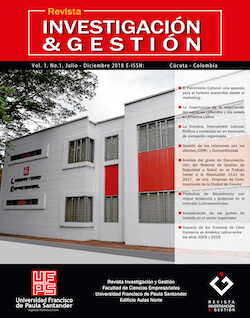Customer Relationship Management (CRM) and competitiveness
Gestión de las relaciones con los clientes (CRM) y competitividad
Main Article Content
The authors Chan Kim and Renée Mauborgne raised in their bestseller "The blue ocean strategy", the need to design differentiating strategies for organizations that are or are entering the market, which seek to avoid certain death by "doing the same" that everyone else does, where these writers call "red oceans" and suggest the search for "blue oceans", used as a metaphor to designate areas of non-competition. For several years now, marketing has been talking about the CRM tool, which stands for Customer Relation ship Management or Customer Relationship Management, as a management strategy. Defined as a philosophy, mechanism or strategy that from information systems focuses efforts on customer knowledge, discovering their needs to increase their degree of satisfaction, extending the scarce and difficult loyalty to the company and increasing the profitability and benefits of the customer to the organization, by analyzing information from them through different media and channels with which they have contact. The efficient management of CRM can become a source of competitive advantage, which through a dynamic development towards schemes such as CEM (customer experience management) can place the organization in the blue oceans. Unfortunately, this strategy
strategy has become a current "snob", which has vulgarized its true value, diverting its real effectiveness, often limited to manage databases that are not tied to any strategy, only represented through customer cards, which long ago ceased to be a surprise, since these swarm. The paper deals with these aspects and the author exposes a proposal that directs through a different approach to CRM.
Downloads
Article Details
Deusto. Wong,Y. H., y Leung, T. (2000). “Guanxi” Relationship marketing in a Chinese Contex.New York, USA: International Business Press. Mc. Graw Hill.
Hitt, M. A., Hoskisson R. E., & Ireland, R. D. (2004). Administración estratégica: competitividad y conceptos de globalización.México: Internacional Thomson Editores. https://issuu.com/cengagelatam/docs/hitt_issuu
Katleen, S. (2003).“CRM a través de Internet”. Barcelona, España: Gestión 2000.
Kaplan, R., & Norton, D. (2004). Mapas Estratégicos. Barcelona, España: Editorial Gestión 2000. https://qualitasbiblo.wordpress.com/wp-content/uploads/2013/03/libro-mapasestratc3a9gicos-kaplan-c2b4n-norton.pdf
Restrepo, M. L. (2006).“Mercadeo relaciona” Hable Directo con el cliente. Bogotá,Colombia: Cargraphics.
Revista Dinero. (2007). ¿Qué quieren los clientes? Recuperado a partir de https://www.dinero.com/pais/articulo/que-quieren-clientes/53887
Stone, B. (2001). Manual de Mercadeo Directo. Bogotá, Colombia: 3R Editores.
Masifern, E., Ricart, J. E., & Villa, J. (1997). “Dirección Estratégica”. Madrid, España: Folio S.A.
Mckenzie, R. (2002).“La Empresa basada en las Relaciones”. Bilbao, España: Ediciones
Ventura, J. (2005). Análisis Dinámico de la Estrategia Empresarial. Bogotá, Colombia: Editorial
Zemke, R., & Albrecht. K. (2001). “Gerencia de clientes”. Bogotá, Colombia: Editorial Legis.







